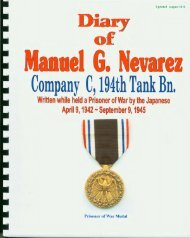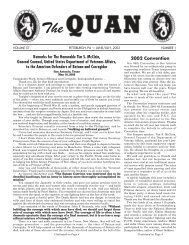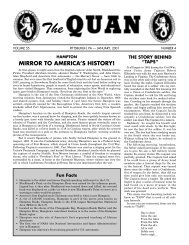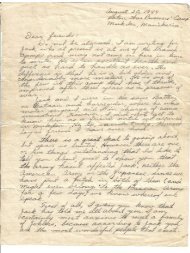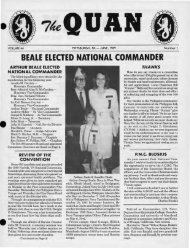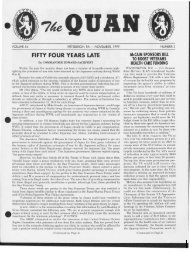Philippine Scouts by Col. John E. Olsen, from the Quan “Stand aside ...
Philippine Scouts by Col. John E. Olsen, from the Quan “Stand aside ...
Philippine Scouts by Col. John E. Olsen, from the Quan “Stand aside ...
Create successful ePaper yourself
Turn your PDF publications into a flip-book with our unique Google optimized e-Paper software.
<strong>Philippine</strong> <strong>Scouts</strong> <strong>by</strong> <strong>Col</strong>. <strong>John</strong> E. <strong>Olsen</strong>, <strong>from</strong> <strong>the</strong> <strong>Quan</strong><br />
<strong>“Stand</strong> <strong>aside</strong>, <strong>the</strong> <strong>Scouts</strong> are coming.” These simple words contained in a poem written<br />
<strong>by</strong> an American officer in a Japanese POW camp shortly after <strong>the</strong> fall of Bataan reflect a<br />
sincere and respectful tribute to some of <strong>the</strong> finest soldiers ever to serve in <strong>the</strong> U.S.<br />
Army. In <strong>the</strong> desperate resistance Gen. Douglas MacArthur’s beleaguered forces on<br />
Bataan and Corregidor put up against <strong>the</strong> Japanese invaders in early 1942, units of <strong>the</strong><br />
<strong>Philippine</strong> <strong>Scouts</strong> were <strong>the</strong> mainstay of <strong>the</strong> defense. When <strong>the</strong> scouts moved up to bolster<br />
<strong>the</strong> hard-pressed units or to attack <strong>the</strong> many landings made <strong>by</strong> <strong>the</strong> Japanese troops behind<br />
<strong>the</strong> main line of resistance, morale or o<strong>the</strong>r Filipino and American troops rose markedly.<br />
Who were <strong>the</strong> <strong>Philippine</strong> <strong>Scouts</strong>? Little known outside <strong>the</strong> <strong>Philippine</strong>s and largely<br />
forgotten <strong>by</strong> <strong>the</strong> U.S. Army of which <strong>the</strong>y were a proud part, <strong>the</strong> <strong>Scouts</strong> were soldiers par<br />
excellence. How did <strong>the</strong> <strong>Philippine</strong> <strong>Scouts</strong> come into <strong>the</strong> U.S. Army and what<br />
contribution did <strong>the</strong>y make to this country’s military heritage?<br />
The <strong>Scouts</strong> were <strong>the</strong> first and last of what some might call American colonial troops. But<br />
<strong>the</strong>y were not colonials. The first Scout organizations were created in 1901 during <strong>the</strong><br />
early days of <strong>the</strong> American occupation of <strong>the</strong> <strong>Philippine</strong> Islands <strong>by</strong> <strong>the</strong> induction of<br />
Filipinos into <strong>the</strong> service of <strong>the</strong> U.S. Armed Forces. Their mission was to help restore<br />
order and peace in a troubled area.<br />
In <strong>the</strong> ensuing two decades, <strong>the</strong> <strong>Philippine</strong> <strong>Scouts</strong> took part in subduing <strong>the</strong> fierce and<br />
warlike Moro tribes on <strong>the</strong> island of Mindanao and in <strong>the</strong> Jolo Archipelago and in<br />
establishing tranquility throughout <strong>the</strong> islands.<br />
Following WWI, Congress approved induction of <strong>the</strong> <strong>Philippine</strong> <strong>Scouts</strong> into <strong>the</strong> regular<br />
U.S. Army. A strength of 6000 was authorized and tactical units were created with<br />
designations of <strong>the</strong> regular establishment, but with <strong>the</strong> suffix (PS) indicating “<strong>Philippine</strong><br />
Scout.”<br />
The <strong>Philippine</strong> Division was activated with two infantry regiments, <strong>the</strong> 45 th (PS) and <strong>the</strong><br />
57 th (PS) subordinate to <strong>the</strong> 23 rd Infantry Brigade of <strong>the</strong> <strong>Philippine</strong> <strong>Scouts</strong>. The<br />
supporting artillery, engineers, quartermaster, medical and o<strong>the</strong>r divisional elements were<br />
manned <strong>by</strong> Filipino enlisted men officered <strong>by</strong> Americans and a few Filipinos. For <strong>the</strong><br />
defense of Manila Bay, two <strong>Philippine</strong> Scout artillery regiments, <strong>the</strong> 91 st and 92 nd , were<br />
created. Last, but not least, <strong>the</strong> 26 th Cavalry Regiment (PS) was formed. They were<br />
stationed on Luzon at Forts Wm. McKinley and Stotsenburg, Camp <strong>John</strong> Hay, <strong>the</strong> Harbor<br />
Defenses of Manila and Petit Barracks on Mindanao.<br />
When war came in 1941, <strong>the</strong> <strong>Scouts</strong> were trained and ready. The 26 th Cavalry Regiment<br />
(PS) supported <strong>by</strong> <strong>the</strong> 23 rd and 24 th FA Battalions, distinguished itself in <strong>the</strong> first days<br />
after <strong>the</strong> initial Japanese landings at Lingayen Gulf in <strong>the</strong> late December <strong>by</strong> attacking <strong>the</strong><br />
assault forces. During <strong>the</strong> stubbornly contested withdrawal of <strong>the</strong> Nor<strong>the</strong>rn Luzon Force,<br />
commanded <strong>by</strong> Lt. Gen. Jonathan Wainwright to <strong>the</strong> Bataan Peninsula, <strong>the</strong> 26 th Cavalry<br />
(PS) was <strong>the</strong> rear guard. Mounted on horses or riding in personnel carriers with thin<br />
armor and only light machine guns, <strong>the</strong> <strong>Scouts</strong> continually and aggressively counter-
attacked <strong>the</strong> Japanese tanks and sacrificed <strong>the</strong>ir lives to protect <strong>the</strong> Filipino and American<br />
troops as <strong>the</strong>y fell back. On Bataan, <strong>the</strong> 14 th Engineers (PS) labored to prepare defensive<br />
positions. Once Bataan was reached, <strong>the</strong> 57 th Infantry (PS) was charged with holding <strong>the</strong><br />
line astride <strong>the</strong> one major road into <strong>the</strong> peninsula. At <strong>the</strong> Battle of Abucay <strong>from</strong> Jan. 11<br />
until Jan. 15, 1942, <strong>the</strong> 57 th Infantry (PS) withstood <strong>the</strong> onslaught of <strong>the</strong> best elements<br />
Gen. Masaharu Homma, Commander-in-Chief of <strong>the</strong> Japanese Expiditionary Forces,<br />
could hurl against it. After four days of bitter hand-to-hand combat, <strong>the</strong> Japanese ceased<br />
<strong>the</strong>ir attempts to penetrate <strong>the</strong> <strong>Scouts</strong>’ line. They shifted <strong>the</strong>ir weight westward into <strong>the</strong><br />
jungle-covered mountains. From <strong>the</strong>re, <strong>the</strong>y outflanked <strong>the</strong> <strong>Scouts</strong> and forced <strong>the</strong>m to<br />
fall back.<br />
But <strong>the</strong> Japanese gained a Pyrrhic victory. So heavy had been <strong>the</strong>ir casualties, that <strong>the</strong>y<br />
gave up <strong>the</strong> attempt to break <strong>the</strong> Filipino and American line on <strong>the</strong> eastern side of <strong>the</strong><br />
peninsula. Instead, <strong>the</strong>y launched a series of amphibious assaults against <strong>the</strong> rear of <strong>the</strong><br />
western flank of General MacArthur’s battered troops. Again, <strong>the</strong>y found <strong>the</strong>mselves<br />
opposed <strong>by</strong> <strong>Philippine</strong> <strong>Scouts</strong>. Not only was <strong>the</strong>ir nemesis <strong>the</strong> 57 th Infantry (PS), but also<br />
two battalions of <strong>the</strong> 57 th ‘s sister regiment, <strong>the</strong> 45 th Infantry (PS)and <strong>the</strong> 8 th and 88 th FA<br />
Battalions(PS). In a series of bloody actions waged in <strong>the</strong> thick jungle at <strong>the</strong><br />
southwestern end of <strong>the</strong> peninsula two enemy infantry battalions of approximately 1,200<br />
men were annihilated. Again, <strong>the</strong> <strong>Scouts</strong> had proved <strong>the</strong>ir superiority.<br />
After two months of regrouping and reinforcing <strong>the</strong>ir troops with new units <strong>from</strong> <strong>the</strong><br />
successful campaign in Malaya, <strong>the</strong> Japanese launched <strong>the</strong>ir final offensive.<br />
Unfortunately, <strong>the</strong> front was too broad for such a small number of <strong>Scouts</strong>. In addition,<br />
<strong>the</strong> enemy were too numerous and too strongly supported <strong>by</strong> artillery and close-support<br />
aircraft. Though Scout artillery outshot <strong>the</strong> enemy and infantry units inflicted more<br />
casualties than <strong>the</strong>y took, <strong>the</strong> odds were too great. Even so, when <strong>the</strong> order came to<br />
surrender on April 9, 1942, <strong>the</strong> <strong>Scouts</strong>’ units were still fighting and were determined to<br />
carry on.<br />
From Corregidor, <strong>the</strong> 91 st and 92 nd Coast Artillery Regiments (PS) fired up to <strong>the</strong> last<br />
minute in spite of heavy bombing and shelling. On <strong>the</strong> island of Mindanao, Companies E<br />
and F, 43 rd Infantry (PS) fought <strong>the</strong> last battle of <strong>the</strong> <strong>Philippine</strong> Campaign. Companies A<br />
and B, 43 rd Infantry (PS) who were cut off <strong>by</strong> <strong>the</strong> initial Japanese landings, withdrew into<br />
<strong>the</strong> mountain provinces of Luzon and became guerillas.<br />
While <strong>the</strong> majority of <strong>the</strong> <strong>Scouts</strong> obeyed <strong>the</strong> order to surrender, <strong>the</strong>ir spirits were not<br />
subdued. Of those who survived <strong>the</strong> Death March and <strong>the</strong> starvation and sufferings at <strong>the</strong><br />
Camp O’Donnell POW camp, or Capis as <strong>the</strong> Filipinos called it, many went out to form<br />
or join guerilla bands to carry on <strong>the</strong> fight after <strong>the</strong>ir release. They harassed <strong>the</strong> enemy<br />
for three years and provided vital intelligence to General MacArthur’s headquarters.<br />
During <strong>the</strong> bleak years of 1942-44, <strong>the</strong>y strove to establish contact with General<br />
MacArthur’s headquarters in Australia and to contest <strong>the</strong> Japanese control of <strong>the</strong><br />
<strong>Philippine</strong>s. When <strong>the</strong> long awaited return of American forces to <strong>the</strong> <strong>Philippine</strong>s arrived<br />
in October 1944, <strong>the</strong>y were met at <strong>the</strong> beaches <strong>by</strong> survivors of <strong>the</strong> <strong>Philippine</strong> <strong>Scouts</strong>. In
<strong>the</strong> months of intense fighting to subdue <strong>the</strong> Japanese forces in <strong>the</strong> <strong>Philippine</strong>s that<br />
followed, <strong>the</strong> former <strong>Scouts</strong> played a major role.<br />
The author of this article, <strong>Col</strong>. <strong>John</strong> E. Olson, USA (Ret.) was adjutant of <strong>the</strong> 57 th<br />
Infantry Regiment of <strong>the</strong> <strong>Philippine</strong> <strong>Scouts</strong>. He won <strong>the</strong> Silver Star for gallantry in action<br />
against <strong>the</strong> Japanese in Bataan. Surviving <strong>the</strong> “Death March,” he was a POW <strong>from</strong><br />
1942-45.



